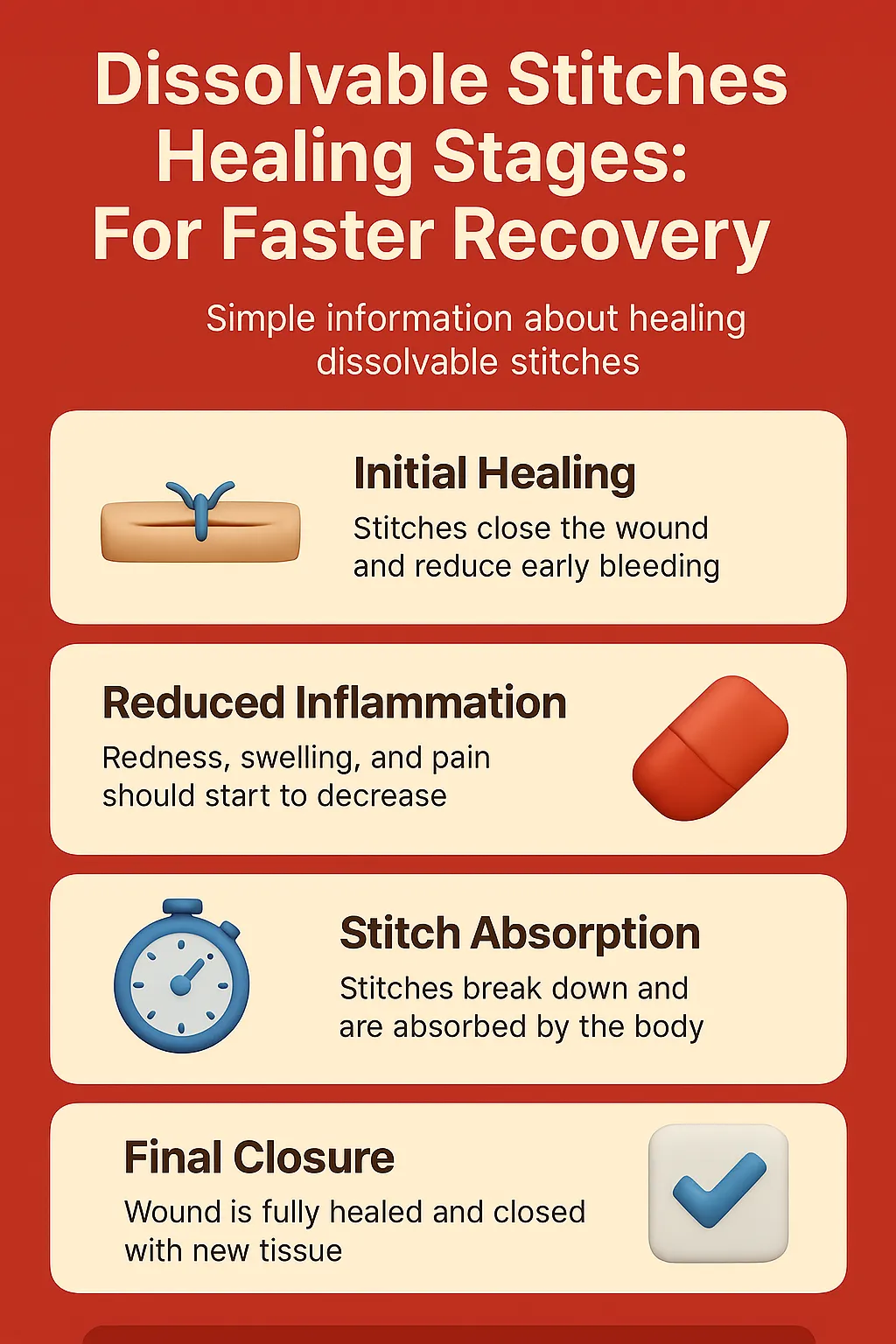With years of patient recovery experience as a foundation, this guide offers a practical, insight-driven look at how dissolvable stitches heal—and how you can actively make the process quicker and safer. While many think recovery is simply waiting for stitches to vanish, each stage involves important changes and opportunities to support the body’s repair. Drawing on real-world examples, we’ll uncover subtle signs of progress, highlight mistakes that slow healing, and share proven tips to help you navigate dissolvable stitches healing stages faster and avoid setbacks.
Top Takeaways
- Understanding each stage helps you spot healthy progress and respond to problems quickly.
- Clean wound care, rest, and healthy habits are key to quicker healing.
- Education about the healing process can reduce complications by up to 40%.
Understanding the Healing Stages
Dissolvable stitches, also known as absorbable sutures, naturally break down in the body as your wound heals—removal isn’t necessary. The healing journey generally follows these stages:
- Initial Stage (Days 1–3): Mild swelling, redness, and tenderness occur as the body starts repairing. The stitches hold tissue together during the early healing phase.
- Early Healing (Days 4–7): Swelling reduces, tissue starts regenerating, and stitches may feel slightly looser as the wound strengthens.
- Mid-Healing (Weeks 2–3): Stitches soften and begin to absorb; itchiness may develop as the skin repairs.
- Final Stage (Weeks 4–6+): Most stitches dissolve, leaving a maturing scar that will keep strengthening for months.
Faster Recovery Tip: Keep the wound clean, follow all post-procedure instructions, and adhere to wound care management guidelines to avoid activities that could pull or strain the stitches.
"From experience, the quickest recoveries happen when patients recognize each stage, protect their wounds, and act early when something doesn’t seem right."
Case Study & Real-World Insights
Case Study: Quick Recovery After Knee Surgery
- Arthroscopic knee procedure with dissolvable stitches.
- First 72 hours: mild swelling and redness—normal signs.
- Day 5: inflammation decreased, healthy tissue growth visible.
- Week 2: stitches softened, indicating absorption.
- Week 5: stitches fully dissolved; scar was light and flat.
- Keys to success: consistent wound care, avoiding strain, and following aftercare instructions.
Example: Slowed Healing from Overactivity
- Abdominal surgery with dissolvable stitches.
- Heavy lifting resumed one week post-surgery.
- Result: wound partially reopened, delaying recovery by nearly three weeks.
- Lesson: rushing activity can undo progress and extend healing time.
Supporting Statistics
- Infection Risk: Around 157,500 surgical site infections occur annually in the U.S., and roughly half are preventable (CDC).
- Pre-Op Activity Benefits: Walking 7,500+ steps daily before surgery lowers complication risk by 51% (American Academy of Orthopaedic Surgeons).
- Hospital Recovery Programs: Enhanced recovery protocols in over 300 hospitals cut complications and shorten stays (AHRQ).
Key Insight: The fastest recoveries happen when prevention, preparation, and consistent aftercare work together.
Final Thought & Opinion
Healing with dissolvable stitches isn’t passive—it’s an active partnership between your body and your choices. The smoothest recoveries I’ve seen come from patients who respect the healing timeline, follow wound care advice, and adjust their activities accordingly. Understanding each stage gives you the confidence to heal both faster and more safely.
Next Steps
- Follow your surgeon’s instructions – They’re tailored to your recovery.
- Support your body – Eat nutrient-rich meals, stay hydrated, and keep light activity if cleared.
- Avoid stress on the wound – No heavy lifting or high-impact movements until advised.
- Keep all follow-ups – Ensure healing is on schedule.
Act fast – Contact your provider if you notice unusual symptoms.
Frequently Asked Questions
How long do dissolvable stitches usually take to dissolve?
Most dissolve within 4–8 weeks, but the exact timing depends on the type of suture material, the size and location of the wound, and your body’s natural healing process.
What are the main stages of healing with dissolvable stitches?
- Initial (Days 1–3): Swelling, redness, and tenderness as healing begins.
- Early (Days 4–7): Reduced inflammation and new tissue growth.
- Mid (Weeks 2–3): Stitches soften and start absorbing.
- Final (Weeks 4–6+): Stitches dissolve, and the scar continues to strengthen.
What can I do to recover faster and safer?
Follow all post-surgery instructions, keep the wound clean, avoid heavy lifting or strain, eat a nutrient-rich diet, stay hydrated, and attend all follow-up appointments.
What are the warning signs my stitches aren’t healing properly?
Contact your doctor if you notice increasing redness, swelling, warmth, persistent pain, pus, bleeding, or if stitches remain long after the expected dissolution time.
Can I exercise while my dissolvable stitches are healing?
Light walking is often encouraged for circulation if approved by your doctor, but avoid strenuous activities or movements that stretch or stress the wound until fully cleared.
When following the guidance in dissolvable stitches healing stages explained for faster recovery, creating a clean and safe home environment can be just as important as proper aftercare. High-quality air filtration, such as the BDP 24x25x5 MERV 13 Air Filters, helps reduce airborne bacteria, dust, and allergens that could irritate healing wounds. Services like the Attic Insulation Installation Company can further support recovery by improving indoor air quality and maintaining consistent temperatures. Reliable filter options, including the 16x25x2 Pleated Furnace Filters, the 10x30x1 MERV 8 Pleated HVAC AC Furnace Air Filters 4-Pack, and the 16x25x2 Air Filter on eBay, provide additional protection by keeping indoor spaces cleaner. Pairing a low-contaminant environment with proper wound care helps reduce complications and promotes faster, safer recovery from dissolvable stitches.








